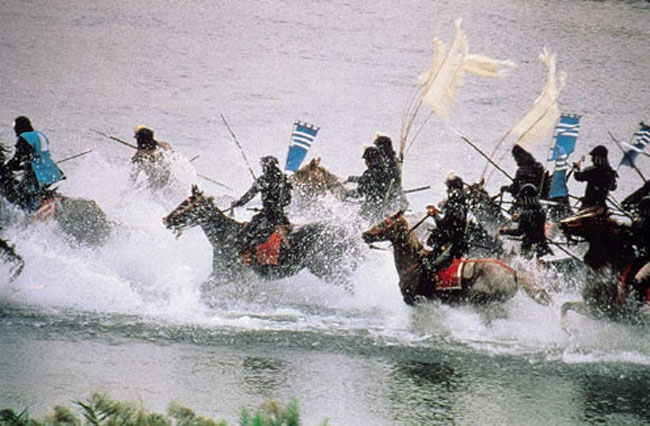CHICAGO – In anticipation of the scariest week of the year, HollywoodChicago.com launches its 2024 Movie Gifts series, which will suggest DVDs and collections for holiday giving.
Akira Kurosawa’s ‘Ran’ a Must-See on the Big Screen
 Rating: 5.0/5.0 |
CHICAGO – Of all the cinematic variations on Shakespeare’s “King Lear,” Akira Kurosawa’s “Ran” is one of the few that, dare I say, improves on the Bard’s original blueprint.
Kurosawa’s vision of Lear is not merely that of an aging warlord undone by his own foolishness, but a ruthless warrior haunted by the countless lives he destroyed during his reign. His fate is anything but undeserved, and seems inspired by classic tragedies more Greek than Shakespearian.
“Ran” may be a devastating experience, but it also proves to be an uplifting one for anyone moved by watching a master filmmaker in peak form. It was an extraordinary triumph for the seventy-five-year-old Kurosawa, battling near-blindness in order to see his decade-old dream project through to its completion.
After a series of professional and personal setbacks, the filmmaker was widely considered to be washed-up, and “Ran” did not receive the attention it deserved upon its initial release in 1985. Seen today, the film is still an overwhelming achievement, with an emotional impact to match its stunning scope and grandeur. When the name Kurosawa is mentioned to contemporary movie buffs, the first three titles that come to mind are “Rashomon,” “Seven Samurai” and “Ran.”
 Photo Credit: © Studio Canal |
Though the film is set in 16th century Japan, and fuses Shakespearian elements with Japanese legends (particularly those concerning warlord Mori Motonari), it is at its core an intensely personal portrait of Kurosawa himself, just as “The Last Temptation of Christ” is ultimately about Scorsese. Kurosawa said that he identified with his “Lear,” Lord Hidetora Ichimonji (Tatsuya Nakadai), who places the control of his kingdom into the hands of his three grown sons. Two of them, Taro (Akira Terao) and Jiro (Jinpachi Nezu) shower Hidetora with flattery, while the youngest son, Saburo (Daisuke Ryû), dares to speak the truth, resulting in his banishment. Like his brothers, Saburo was brought up in a “world bereft of loyalty,” and views his father’s trust as the characteristic of a “senile old fool.” Hidetora soon discovers that his son was correct, as Taro and Jiro gradually strip him of his bodyguards, concubines and finally his sanity. It’s a timeless parable of violence begetting violence throughout generations.
While Hidetora’s sons are responsible for moving the plot forward, they often remain in the background, and are mainly represented by their color-coded armies. A considerable portion of the film’s power should be attributed to the towering central performance by Nakadai, who starts out as the thunderous embodiment of formidably regal authority, and disintegrates into a gaunt, trembling ghost of a broken mortal. There’s a moment when his horrified face nearly resembles Edward Munch’s infamous painting, “The Scream.”
 Photo Credit: © Studio Canal |
Some of the film’s most touching scenes involved the mad Hidetora’s wanderings with his loyal jester Kyoami (the androgynous Peter), who switches roles with his crazed master, uttering bitter truths like a one-man Greek chorus. The other great performance in the picture also seems heavily influenced by Noh theatre. As the vengeful Lady Kaede, Mieko Harada has the mesmerizing presence of a rattlesnake poised to strike at any moment. In her seduction scene with Jiro, Harada must fluctuate from humbled obedience to maniacal bloodlust to sexual hunger and feigned weeping, and somehow manages to pull it off brilliantly.
Yet of course, the real star of “Ran” is Kurosawa, whose god-like perspective often observes action from a distance, allowing character dynamics to be absorbed, while making the humans seem like minor figures on a vast landscape devoid of divine intervention. Perhaps the most spectacular sequence in the film is the central massacre unleashed by Taro and Jiro’s forces, leading to an unforgettable shot of Hidetora sitting in a daze as fiery chaos engulfs his surroundings. Much of the scene plays out in silence, with Toru Takemitsu’s hypnotic score accompanying the gory carnage until it is interrupted by a key gunshot. When Hidetora emerges from a smoke-filled doorway and leaves the burning castle through a parting wall of enemy troops, the moment is as iconic and deeply tragic as Orson Welles’s final walk through the hallway in “Citizen Kane.”
This year marks not only the twenty-fifth anniversary of “Ran,” but also the hundredth birthday of Kurosawa, who died in 1998. To commemorate this grand masterpiece, a new 35mm print of the film is currently playing at the Music Box. If you haven’t had the opportunity to experience the color, the majesty and the awesome spectacle of “Ran” on the big screen, this is one moviegoing experience you can’t afford to miss.
 | By MATT FAGERHOLM |


